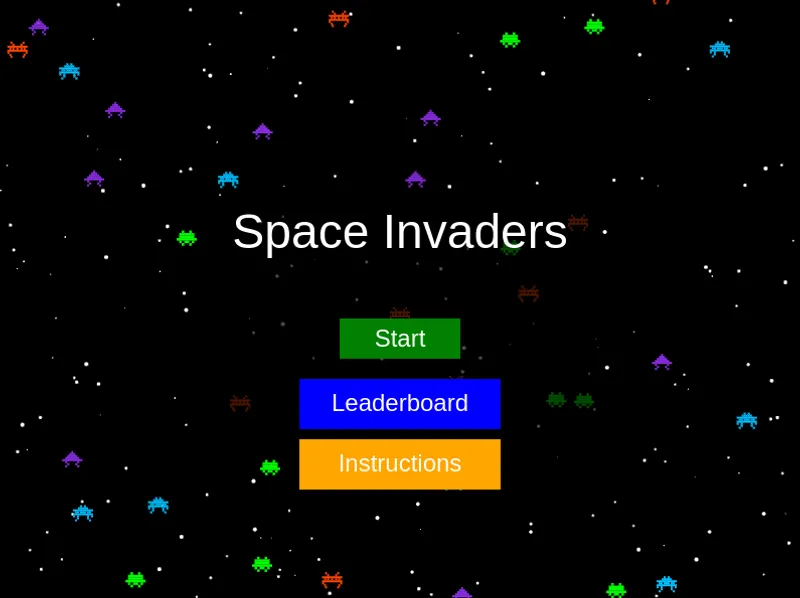Space Invaders
Remake of the classic Space Invaders game using JavaScript, HTML, and CSS.

About This Project
Space Invaders defined a generation of arcade gaming, and I decided to give it a modern revival. In this project, I rebuilt Space Invaders using JavaScript with the HTML5 Canvas for rendering, styled it with CSS, and built a backend using Node.js and Express to manage a global leaderboard stored in PostgreSQL. To top it off, I containerized the full-stack application using Docker for easy deployment.
Features
- Classic Gameplay: Faithfully recreates the original Space Invaders experience.
- Real-Time Action: Smooth enemy movements and fast-paced collisions to keep the action engaging.
- Global Leaderboard: Submit and view high scores with a persistent PostgreSQL-backed leaderboard.
- Full-Stack Modernization: Combines frontend JavaScript with a robust Node.js backend.
- Dockerized Deployment: Seamlessly deploy the application in any environment using Docker and Docker Compose.
Technical Implementation
Frontend – JavaScript, HTML5 Canvas, CSS
-
Game Loop & Entity Management:
TheGame.jsclass handles the main game loop, updating game entities (player, enemies, bullets) and rendering the scene.// src/game/Game.js export class Game { // ... constructor and other methods ... gameLoop(currentTime) { const deltaTime = (currentTime - this.lastTime) / 1000; this.lastTime = currentTime; this.update(deltaTime); this.draw(); requestAnimationFrame(this.gameLoop.bind(this)); } update(deltaTime) { if (!this.isGameStarted || this.isPaused) { return; } // ... game logic ... } // ... additional methods for drawing, input handling, etc. ... } -
Rendering & UI:
The rendering logic is separated into aRenderer.jsclass which draws all visual elements—from the background and game entities to score displays and UI pop-ups. -
Game Entities:
Classes such asPlayer.js,Enemy.js,Bullet.js, andBarrier.jsencapsulate the behavior and interactions of game objects.
Backend – Node.js, Express, PostgreSQL
-
API Endpoints:
The backend (inserver.js) exposes API endpoints to add and retrieve leaderboard scores. It uses an Express server and connects to PostgreSQL using thepgmodule.// server.js import express from 'express'; import pkg from 'pg'; const { Pool } = pkg; import cors from 'cors'; const app = express(); app.use(express.json()); app.use(cors()); const pool = new Pool({ connectionString: process.env.DATABASE_URL, }); // Add score to leaderboard app.post('/api/leaderboard', async (req, res) => { // ... implementation ... }); // Get top 10 scores app.get('/api/leaderboard', async (req, res) => { // ... implementation ... }); const PORT = process.env.PORT || 3000; app.listen(PORT, '0.0.0.0', () => console.log(`Server running on port ${PORT}`));
Dockerized Deployment
-
Docker & Docker Compose:
The project uses Docker to package the application and its dependencies. ADockerfilebuilds the application image, and adocker-compose.ymlfile sets up both the application and a PostgreSQL database.# docker-compose.yml version: '3.8' services: db: # ... database configuration ... app: build: context: . dockerfile: Dockerfile ports: - "3000:3000" depends_on: - db # ... additional configurations ...
To start the entire application, simply run:
docker-compose up -d
Development Process
This project involved an iterative development process:
- Prototype to Production: Started with a single-player prototype and gradually integrated multiplayer mechanics and backend services.
- Tackling Challenges: Fine-tuning enemy behavior, implementing precise collision detection, and managing asynchronous database operations were the core challenges.
- Learning & Refinement: From mastering Docker to optimizing the game loop, each step provided valuable insights into both game development and full-stack programming.
Get the Code and Play!
- Live Demo: Play the Game
- GitHub Repository: Source Code
I encourage you to clone the repository, explore the code, and even contribute your improvements!
Future Enhancements
- Multiplayer Mode: Exploring real-time multiplayer possibilities with WebSockets.
- Advanced Collision Mechanics: Adding enhanced collision responses for improved gameplay.
- Enhanced Visuals & Sound: Integrating sound effects and dynamic visuals to enrich the gaming experience.